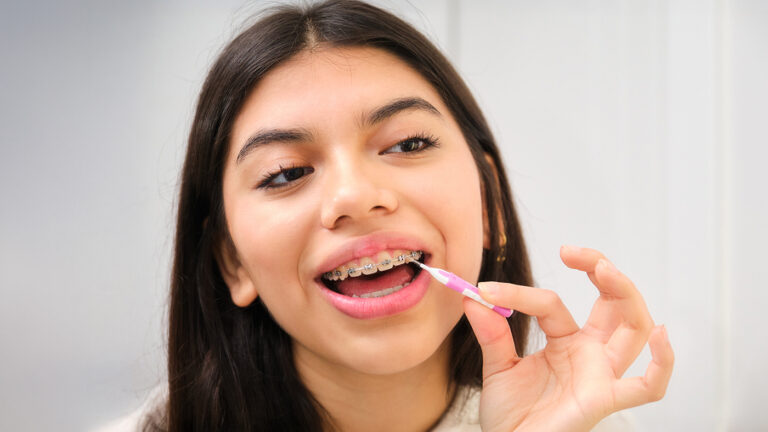In decades past, braces were almost exclusively worn by teenagers, so much so that they’ve become associated with that specific period of life. More recently, however, many kids have begun orthodontic treatment when they’re much younger.
At what age do kids usually get braces?
It’s worth noting that not all kids need orthodontic work at a young age. Every person is different, and whether your child will benefit from braces or other orthodontic treatment will depend on a few factors. A pediatric dentist can point out concerns and make a recommendation. Then, a trained orthodontist will give you the most transparent picture and roadmap.
Historically, kids have begun orthodontic treatments at age 12 to 14, once all of the primary teeth have fallen out and the adult teeth are mostly in place. Nowadays, when can kids get braces? Some kids start getting orthodontic treatment between 8 and 12, depending on their specific needs and may have braces in two phases.
Many parents believe there’s no point in orthodontic treatment until the adult teeth have arrived. However, starting before the mouth fully matures can offer a wider range of options to avoid complex cases and enhance better outcomes. This makes it important to consider the best age for orthodontic treatment based on your child’s unique dental development.
Why does my child need braces early?
Over the last 10 or 20 years, developments in orthodontic treatments and updated information have led to orthodontic treatment at earlier ages. It’s common to see a kid in braces before they’ve reached double digits. Parents often wonder how early can kids get braces—the answer depends on the individual case and professional evaluation.
Your dentist, pediatrician, or orthodontist may recommend early treatment if they identify an issue that will be easier to treat now rather than later. This helps avoid a more significant problem as your child grows. Early treatment (often called Phase 1 treatment) is applied to correct a problem with the front four upper and lower teeth and the developing upper and lower jaw. Phase 1 treatment may be appropriate if your child has:
- Tooth gaps. Some gaps in their teeth are caused by early tooth loss. If left untreated, this can cause other teeth to shift, leading to even more significant problems.
- Overcrowded teeth. Kids may experience some pain or discomfort and difficulty chewing and speaking if there isn’t enough room in the mouth.
- Crooked teeth. Misaligned teeth are more difficult to clean and more prone to buildup and gum disease. Treatment can improve social benefits and self-esteem that come with a straight smile.
- Jaw misalignments. Underbites, overbites, and crossbites can affect your child’s ability to speak, chew, and even breathe properly.
These are all concerns that fall under orthodontic treatment for children and should be addressed as early as possible when recommended.
What are the benefits of early orthodontic treatment?
When your child is young, their teeth and jaws are more pliable and more responsive to early orthodontic treatment. You can think of the jaw as plaster and the teeth as stones in the plaster. Over time, the plaster sets, and moving the stones becomes more difficult. The earlier you address any concerns, the easier and quicker it will be to align things.
A missing tooth might not seem like a problem, especially if your child has new teeth coming in, but a small problem today can become a big problem tomorrow. Gaps allow teeth to shift, potentially blocking the eruption of adult teeth. If that happens, the adult teeth may come in crooked or in the wrong spot entirely.
On the same token, relatively minor misalignments in the jaw can become more pronounced over time or cause teeth to wear unevenly. Early child orthodontic treatment can help prevent these issues from becoming more complex later.
Your kiddo may get through their adolescence alright, only to discover a more serious issue in adulthood. Early treatment could prevent the need for more complex treatment later or reduce the complexity or the length of treatment if Phase 2 treatment is still needed.
When should my child visit the orthodontist?
The American Association of Orthodontists recommends taking your child to an orthodontist by their seventh birthday. At that point, kids usually have a mixture of primary teeth (baby teeth) and adult teeth. It might feel a little premature, but an orthodontist will be able to get a sense of how your child’s mouth is developing and changing. With our comprehensive care model, your pediatric dentist and orthodontist can work together to identify any potential concerns and give you a plan to address them early.
That recommendation answers the common question: when should a child first see an orthodontist? The earlier the visit, the more informed your decisions will be as their teeth and jaws develop.
You’ll get the support you need to make the right decision for your family and ensure your child is all smiles. Understanding the average age for braces —which is typically between 12 and 14— and how it applies to your child can make all the difference when considering orthodontics for children and planning for the future.




